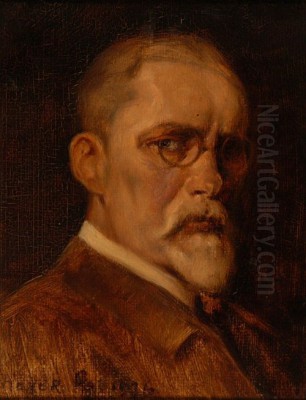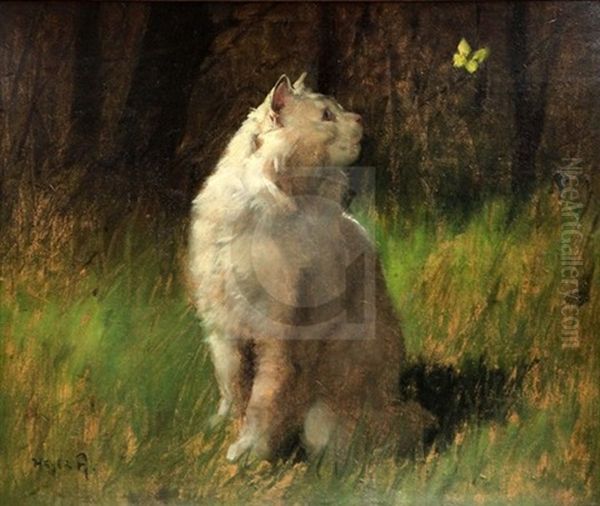
Arthur Heyer stands as a notable figure in the realm of animal painting, bridging German artistic training with a career largely based in Hungary. Born in Haarhausen, Germany, on February 28, 1872, and passing away in Budapest, Hungary, in 1931, Heyer carved a niche for himself through his sensitive and highly detailed depictions of animals, with a particular fondness and mastery for portraying cats. His life and work reflect a dedication to capturing the essence of his subjects, earning him recognition and a lasting appeal among admirers of animal art. His dual German-Hungarian identity shaped his career path and the reception of his work across Central Europe.
Early Life and Artistic Formation
Arthur Heyer's journey into the art world began in Germany. He was the son of Georg Hermann Heyer and Friederica Wehrli. While born in Haarhausen, Thuringia, his family later relocated to Gotha, another town in the same region. It was clear from early on that Heyer possessed artistic inclinations. This talent led him to pursue formal art education in the bustling artistic center of Berlin.
From 1890 to 1895, Heyer studied at the prestigious Unterrichtsanstalt des Kunstgewerbemuseums Berlin (the teaching institute associated with the Museum of Decorative Arts). This institution provided rigorous training in various artistic disciplines. During his time there, he had the significant opportunity to study under Max Friedrich Koch, a respected history painter. This training under Koch would have grounded Heyer in academic principles of drawing, composition, and likely, anatomical accuracy, skills that would prove invaluable in his later specialization.
Relocation to Budapest and Career Shift
A pivotal moment in Heyer's life and career occurred in 1896 when he decided to move to Budapest, the vibrant capital of Hungary. This move marked the beginning of his professional life as an independent artist. Initially, Heyer did not focus exclusively on animals; his early works included landscape paintings, reflecting perhaps a broader interest or the influence of prevailing trends.

However, his artistic direction soon shifted decisively towards animal painting. It was in this genre that Heyer found his true calling and achieved his greatest success. He became particularly renowned for his depictions of cats, especially white Angora or Persian cats, whose luxurious fur and elegant postures he rendered with exceptional skill and sensitivity. Budapest would remain his home base for the rest of his life, and he became an integrated part of the Hungarian art scene.
Artistic Style and Beloved Subjects
Arthur Heyer's style is firmly rooted in Realism. He possessed a keen eye for detail and a remarkable ability to capture the textures of fur, the subtle nuances of animal anatomy, and the spark of life in their eyes. His works are characterized by meticulous brushwork and a careful rendering of light and shadow, which contribute to the lifelike quality of his subjects.
While technically proficient, Heyer's paintings are more than mere anatomical studies. He imbued his animal portraits with personality and warmth. His depictions often carry a sense of intimacy and gentle humor, capturing moments of quiet contemplation, playful interaction, or regal repose. This approach resonated with audiences, lending his work an accessible and endearing quality. His paintings, particularly those of fluffy white cats, have sometimes been described as having a "chocolate box" charm – a term suggesting a pleasing, perhaps slightly sentimental, but undeniably skillful and attractive aesthetic that was highly popular.
Cats were undoubtedly Heyer's most frequent and celebrated subjects. He seemed fascinated by their grace, independence, and expressive potential. He often depicted them in domestic settings, lounging on cushions, interacting with objects, or simply gazing out at the viewer with captivating intensity. Beyond cats, Heyer also painted dogs and other animals, always applying the same careful observation and sympathetic portrayal.
Notable Works and Recognition
Throughout his career, Arthur Heyer produced a significant body of work. While a comprehensive catalogue might be extensive, certain paintings stand out as representative of his skill and focus. Titles like "Persian Cats," "Sitting Dog," and "Two White Angora Cats" exemplify his preferred subject matter and artistic approach. These works showcase his mastery in rendering fur, capturing characteristic poses, and conveying the individual 'personality' of the animal.
Heyer's talent did not go unnoticed. He actively participated in the art world, exhibiting his paintings in both Hungary and Germany. His work gained appreciation from critics and the public alike. A significant milestone in his career was receiving the prestigious Andrássy Prize in Hungary in 1911. This award underscored his standing within the Hungarian art community and recognized the quality and appeal of his animal paintings.
Work as an Illustrator

Beyond his easel paintings, Arthur Heyer also applied his talents to illustration. He contributed artwork to various publications, notably creating illustrations for animal-themed books published by houses such as Verlag Franklin Tarsalut in Budapest. This work allowed his art to reach a wider audience beyond gallery walls.
His skill in detailed and appealing animal representation made him a natural fit for book illustration. These illustrations likely further cemented his reputation as a premier animal artist. The reproducibility of illustrations meant that images of his charming cats and dogs could be enjoyed in homes and libraries, contributing to his lasting popularity and the dissemination of his characteristic style.
Contextualizing Heyer: Animal Painting in His Era
Arthur Heyer worked during a period when animal painting, or animalier art, enjoyed considerable popularity, yet was also undergoing stylistic evolution. The tradition had strong roots in the 19th century, with artists achieving fame through their focus on animal subjects. To understand Heyer's place, it's helpful to consider him alongside other prominent artists who engaged with similar themes, though often with different approaches.
In France, the legacy of Rosa Bonheur (1822-1899) loomed large. Bonheur was internationally celebrated for her powerful, realistic depictions of farm animals and wildlife, executed on a grand scale. Contemporary to Bonheur was Constant Troyon (1810-1865), associated with the Barbizon School, who often incorporated animals, particularly cattle, into atmospheric landscape settings. Heyer's focus on domestic pets, often in interior settings, offers a contrast to the more rustic or heroic scale of Bonheur or Troyon.
Britain had its own towering figure in Sir Edwin Landseer (1802-1873), whose dramatic and often anthropomorphized paintings of dogs (like "The Old Shepherd's Chief Mourner") and stags ("The Monarch of the Glen") were immensely popular in the Victorian era. Earlier, George Stubbs (1724-1806) had set a standard for equine portraiture with his unparalleled anatomical accuracy. Heyer's work, while realistic, generally avoided the overt sentimentality or narrative drama often found in Landseer.
Within the German-speaking world, artists like Heinrich von Zügel (1850-1941) were exploring Impressionistic techniques to capture animals within their environment, focusing on light and movement. Wilhelm Kuhnert (1865-1926), a contemporary of Heyer, gained fame for his dramatic paintings of African wildlife, based on direct observation during his travels. Heyer's meticulous realism and focus on domestic animals place him in a different niche compared to Zügel's impressionistic handling or Kuhnert's exotic subject matter. Looking back further, the Dutch Golden Age provided masters like Paulus Potter (1625-1654), known for his detailed paintings of livestock in pastoral settings. In Belgium, Alfred Verwee (1838-1895) was known for his realistic portrayal of cattle.
When considering artists specifically known for cats, Henriëtte Ronner-Knip (1821-1909), working in the Netherlands and Belgium, stands out as a direct and highly successful contemporary specializing in charming, detailed paintings of cats and kittens, often in playful domestic scenes. Her work shares similarities with Heyer's in subject and meticulousness. Théophile Steinlen (1859-1923), active in Paris, frequently depicted cats in his posters and illustrations, but often with a looser, more graphic style characteristic of Art Nouveau. Later, Louis Wain (1860-1939) in England would become famous for his increasingly anthropomorphic and psychedelic cat drawings. Even artists not specializing in animals, like Édouard Manet (1832-1883), included cats memorably in works such as "Olympia," highlighting the animal's presence in modern life and art.
Heyer's contribution lies in his consistent dedication to realistic, yet warm and engaging, portrayals of domestic animals, particularly cats. He operated within a well-established genre but developed a recognizable style characterized by technical polish and gentle charm, distinct from the grander narratives of Bonheur or Landseer, the impressionistic explorations of Zügel, or the graphic dynamism of Steinlen. While there is no record of direct collaboration between Heyer and these other artists, his work clearly belongs to this rich and varied tradition of animal depiction in European art.
A Glimpse into the Artist's Life
While much of the focus is on his artistic output, a small anecdote offers a glimpse into Arthur Heyer's personality beyond the canvas. It is recounted that during a holiday around 1920, seeking perhaps a different creative outlet or simply to pass the time, Heyer wrote an eighteenth-century story described as being filled with passion and romance. This suggests a man with imaginative interests extending beyond visual art, hinting at a romantic sensibility that perhaps also subtly informed the charm found in his paintings.
Later Life and Enduring Legacy
Arthur Heyer continued to paint and live in Budapest until his death in 1931 at the age of 59. He left behind a substantial oeuvre dedicated primarily to the celebration of animal life. His legacy is that of a highly skilled and specialized painter who excelled in capturing the beauty and personality of domestic animals, especially cats.
His work achieved considerable popularity during his lifetime, finding favor with collectors and the public through exhibitions and published illustrations. This popularity endures today. Heyer's paintings are still appreciated for their technical mastery, particularly the rendering of fur and expressive detail, and for their inherent charm and warmth. Reproductions of his cat paintings remain widely circulated, testament to their timeless appeal. He holds a secure place among the notable animal painters of the late 19th and early 20th centuries, remembered particularly as a master of feline portraiture whose work continues to delight viewers. His dedication to his chosen subject, combined with his fine-tuned realistic style, ensures his continued recognition in the history of animal art.